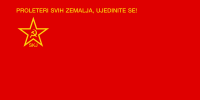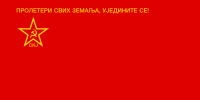The League of Communists of Yugoslavia,[a] known until 1952 as the Communist Party of Yugoslavia,[b] was the founding and ruling party of SFR Yugoslavia. It was formed in 1919 as the main communist opposition party in the Kingdom of Serbs, Croats and Slovenes and after its initial successes in the elections, it was proscribed by the royal government and was at times harshly and violently suppressed. It remained an illegal underground group until World War II when, after the invasion of Yugoslavia in 1941, the military arm of the party, the Yugoslav Partisans, became embroiled in a bloody civil war and defeated the Axis powers and their local auxiliaries. After the liberation from foreign occupation in 1945, the party consolidated its power and established a one-party state, which existed in that form of government until 1990, a year prior to the start of the Yugoslav Wars and breakup of Yugoslavia.
The party, which was led by Josip Broz Tito from 1937 to 1980, was the first communist party in power in the history of the Eastern Bloc that openly opposed the Soviet Union and thus was expelled from the Cominform in 1948 in what is known as the Tito–Stalin split. After internal purges of pro-Soviet members, the party renamed itself the League of Communists in 1952 and adopted the politics of workers' self-management and an independent path to achieving socialism, known as Titoism.
- ^ Warner Neal, Fred (March 1957). "The Communist Party in Yugoslavia". American Political Science Review. 51 (1): 88–111. doi:10.2307/1951773. JSTOR 1951773. S2CID 146357000. Retrieved 10 August 2023.
- ^ Majstorovic, Steven (June 1987). Yugoslavia's Communist party: Implications of the nationalities problem". Graduate Student Theses, Dissertations, & Professional Papers (Thesis). University of Montana. pp. 12, 94, 104, 111.
- ^ "Yugoslavia". Daily Report, Foreign Radio Broadcasts. No. 231–232. The Ohio State University: United States, Central Intelligence Agency. 28 November 1962. p. 13. OCLC 1541329.

- ^ Bockman, Johanna (26 July 2011). "Yugoslav Economics". Markets in the Name of Socialism: The Left-Wing Origins of Neoliberalism. Stanford University Press. p. 82. ISBN 9780804775663. OCLC 1015120513.
- ^ Riff, Michael (1987). Dictionary of Modern Political Ideologies. Manchester University Press. p. 61. ISBN 9780719032899.
- ^ Besier, Gerhard; Stokłosa, Katarzyna (2014). European Dictatorships: A Comparative History of the Twentieth Century. Cambridge Scholars Publishing. p. 322. ISBN 9781443855211.
- ^ Gibianskii 2012, p. 230.
- ^ Kranjc 2013, p. 37.
- ^ Adams, Sean; Morioka, Noreen; Stone, Terry Lee (2006). Color Design Workbook: A Real World Guide to Using Color in Graphic Design. Gloucester, Massachusetts: Rockport Publishers. pp. 86. ISBN 159253192X. OCLC 60393965.
Cite error: There are <ref group=lower-alpha> tags or {{efn}} templates on this page, but the references will not show without a {{reflist|group=lower-alpha}} template or {{notelist}} template (see the help page).


